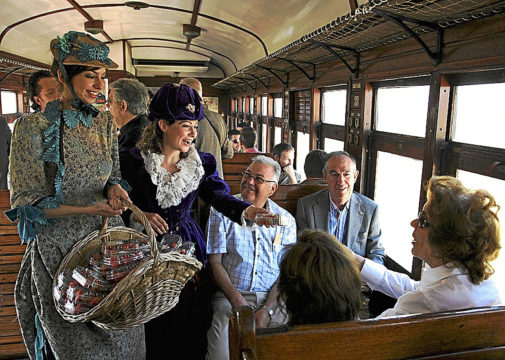Travel as it used to be. Four routes offer this experience in four cardinal points of the Community of Madrid: El Escorial, Aranjuez, Alcalá or Arganda.
To the northwest, you can learn about the history and cultural richness of El Escorial, uploaded to the wagons and the locomotive of the Felipe II Train , which date from 1940 and can accommodate 232 people. They leave in the morning in two shifts - at 9:10 or 10: 20-, from the Principe Pio station to tour the Sierra de Guadarrama.
On board, reviewers characterized as characters from the 16th-century court accompany travelers on this time travel . After 50 minutes with your eyes on the monastery, the convoys enter the platform.
Changing destination and monarch, and looking south of the Madrid Community, we arrived until the 19th century of Isabel II . To travel to this time, there is a journey, which the legend tells that it had silver rails. The trip to Aranjuez pays tribute for 35 years the arrival of the train to Spain, the beginning of industrialization in the country back in 1851.
'The Train of the Strawberry' was the first railway journey of the Community of Madrid and the second of Spain, an initiative that tried to unite the Mediterranean with the capital and that extended until the palace of Aranjuez for comfort of the Royalty.
Tour of the Jarama valley
For three decades now, this Japanese locomotive has revived the journey, known as the red fruit . A nickname that comes from the possibility of tasting this typical product of the area along the way.
Jumping to a somewhat more humble route in the historical sense, to the east, the Arganda Train leaves a trail of smoke when it reaches the Jarama river and crosses the metal bridge that crosses it. "The train of Arganda, which whistles more than it goes", laughs the popular joke, referring to how the travelers got off and on the march.
Composed of centuries-old wooden cars, this convoy travels almost four kilometers along the only preserved section of the old Tajuña railway. It is a journey in a steam locomotive, with mythical restored wagons and a tour of the Jarama valley to a museum with memories and antiques , which reproduce the atmosphere of a historic station.
Tribute to Cervantes
The goal is to remember how it was traveled and how it worked a century ago. Thus, the locomotive works based on coal and reaches up to 50 degrees. The actors represent trades that have already disappeared, like stokers or brakemen .
Finally, looking northeast, you could not miss the city of Alcala de Henares, much less its illustrious inhabitant: Cervantes. To get to know it in depth, between September 14 and December 14, the Cervantes Train starts a literary journey from Atocha station to Alcalá.
This modern train takes a tour through the Cervantes works and, during the journey, the actors make representations of the author of El Quijote to liven up the trip. These are four different ways of knowing the Madrid past, but also of living it.
According to the criteria of The Trust Project
Know more
